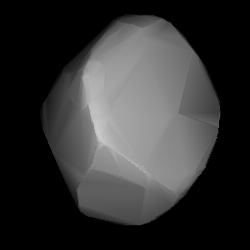 Modelled shape of Chandra from its lightcurve Modelled shape of Chandra from its lightcurve | |
| Discovery | |
|---|---|
| Discovered by | C. U. Cesco |
| Discovery site | El Leoncito (Yale–Columbia Station) |
| Discovery date | 24 September 1970 |
| Designations | |
| MPC designation | (1958) Chandra |
| Named after | Subrahmanyan Chandrasekhar (astrophysicist) |
| Alternative designations | 1970 SB · 1947 HD 1959 RG1 · 1965 UN 1971 XA |
| Minor planet category | main-belt · (outer) |
| Orbital characteristics | |
| Epoch 4 September 2017 (JD 2458000.5) | |
| Uncertainty parameter 0 | |
| Observation arc | 62.66 yr (22,887 days) |
| Aphelion | 3.6220 AU |
| Perihelion | 2.5840 AU |
| Semi-major axis | 3.1030 AU |
| Eccentricity | 0.1673 |
| Orbital period (sidereal) | 5.47 yr (1,997 days) |
| Mean anomaly | 233.69° |
| Mean motion | 0° 10 49.08 / day |
| Inclination | 10.559° |
| Longitude of ascending node | 345.04° |
| Argument of perihelion | 318.95° |
| Physical characteristics | |
| Dimensions | 33.82 km (derived) 34.278±0.220 36.167±0.349 km |
| Synodic rotation period | 7.0571±0.0029 h 7.070±0.004 h |
| Geometric albedo | 0.0511 (derived) 0.0709±0.0138 0.082±0.007 |
| Spectral type | C |
| Absolute magnitude (H) | 10.7 · 11.102±0.003 (R) · 11.18±0.18 · 11.2 |
1958 Chandra (prov. designation: 1970 SB) is a dark background asteroid from the outer region of the asteroid belt, approximately 35 kilometers (22 miles) in diameter. It was discovered on 24 September 1970, by Argentinian astronomer Carlos Cesco at the Yale–Columbia Southern Station of the Leoncito Astronomical Complex in San Juan, Argentina (also see Félix Aguilar Observatory). It was named after astrophysicist Subrahmanyan Chandrasekhar.
Orbit and classification
Chandra is a dark C-type asteroid that orbits the Sun in the outer main-belt at a distance of 2.6–3.6 AU once every 5 years and 6 months (1,997 days). Its orbit has an eccentricity of 0.17 and an inclination of 11° with respect to the ecliptic. In April 1947, the asteroid was first identified as 1947 HD at Algiers Observatory. The body's observation arc begins 16 years prior to its official discovery observation with a precovery taken at Palomar Observatory in 1954.
Naming
This minor planet was named in honor of Subrahmanyan Chandrasekhar (1910–1995), the Nobel Prize winning Indian–American theoretical astrophysicist (also see Chandrasekhar limit). The approved naming citation was published by the Minor Planet Center on 1 November 1979 (M.P.C. 5013).
Physical characteristics
Photometry
In December 2010, a rotational lightcurve was obtained for this asteroid from photometric observations at the U.S. Palomar Transient Factory, California. It gave a rotation period of 7.0571±0.0029 hours with a brightness variation of 0.35 magnitude (U=2). A second lightcurve, obtained by Italian amateur astronomer Silvano Casulli in August 2014, gave a concurring period of 7.070±0.004 hours with an amplitude of 0.38 in magnitude (U=3-).
Diameter and albedo
According to the survey carried out by the NEOWISE mission of NASA's Wide-field Infrared Survey Explorer, the asteroid measures 36.2 kilometers in diameter and its surface has an albedo of 0.07, while the Collaborative Asteroid Lightcurve Link derives an albedo of 0.05 and a diameter of 33.8 kilometers with an absolute magnitude of 11.2.
References
- ^ "JPL Small-Body Database Browser: 1958 Chandra (1970 SB)" (2017-06-04 last obs.). Jet Propulsion Laboratory. Retrieved 2 July 2017.
- ^ Schmadel, Lutz D. (2007). "(1958) Chandra". Dictionary of Minor Planet Names. Springer Berlin Heidelberg. p. 157. doi:10.1007/978-3-540-29925-7_1959. ISBN 978-3-540-00238-3.
- ^ "LCDB Data for (1958) Chandra". Asteroid Lightcurve Database (LCDB). Retrieved 25 August 2016.
- ^ Masiero, Joseph R.; Grav, T.; Mainzer, A. K.; Nugent, C. R.; Bauer, J. M.; Stevenson, R.; et al. (August 2014). "Main-belt Asteroids with WISE/NEOWISE: Near-infrared Albedos". The Astrophysical Journal. 791 (2): 11. arXiv:1406.6645. Bibcode:2014ApJ...791..121M. doi:10.1088/0004-637X/791/2/121. Retrieved 8 December 2016.
- ^ Mainzer, A.; Grav, T.; Masiero, J.; Hand, E.; Bauer, J.; Tholen, D.; et al. (November 2011). "NEOWISE Studies of Spectrophotometrically Classified Asteroids: Preliminary Results". The Astrophysical Journal. 741 (2): 25. arXiv:1109.6407. Bibcode:2011ApJ...741...90M. doi:10.1088/0004-637X/741/2/90.
- ^ Waszczak, Adam; Chang, Chan-Kao; Ofek, Eran O.; Laher, Russ; Masci, Frank; Levitan, David; et al. (September 2015). "Asteroid Light Curves from the Palomar Transient Factory Survey: Rotation Periods and Phase Functions from Sparse Photometry". The Astronomical Journal. 150 (3): 35. arXiv:1504.04041. Bibcode:2015AJ....150...75W. doi:10.1088/0004-6256/150/3/75. Retrieved 25 August 2016.
- ^ Behrend, Raoul. "Asteroids and comets rotation curves – (1958) Chandra". Geneva Observatory. Retrieved 25 August 2016.
- Veres, Peter; Jedicke, Robert; Fitzsimmons, Alan; Denneau, Larry; Granvik, Mikael; Bolin, Bryce; et al. (November 2015). "Absolute magnitudes and slope parameters for 250,000 asteroids observed by Pan-STARRS PS1 - Preliminary results". Icarus. 261: 34–47. arXiv:1506.00762. Bibcode:2015Icar..261...34V. doi:10.1016/j.icarus.2015.08.007. Retrieved 25 August 2016.
- ^ "1958 Chandra (1970 SB)". Minor Planet Center. Retrieved 25 August 2016.
- "MPC/MPO/MPS Archive". Minor Planet Center. Retrieved 25 August 2016.
External links
- Asteroid Lightcurve Database (LCDB), query form (info Archived 21 July 2011 at the Wayback Machine)
- Dictionary of Minor Planet Names, Google books
- Asteroids and comets rotation curves, CdR – Observatoire de Genève, Raoul Behrend
- Discovery Circumstances: Numbered Minor Planets (1)-(5000) – Minor Planet Center
- 1958 Chandra at AstDyS-2, Asteroids—Dynamic Site
- 1958 Chandra at the JPL Small-Body Database

| Minor planets navigator | |
|---|---|
| Small Solar System bodies | |||||||
|---|---|---|---|---|---|---|---|
| Minor planets |
| ||||||
| Comets | |||||||
| Other | |||||||